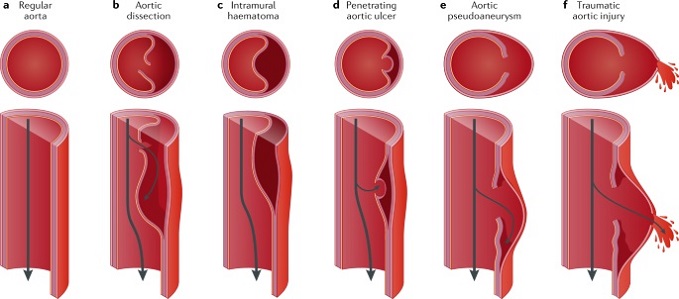Utah study reveals that COVID-19 and Influenza increase risk of Acute Aortic Syndrome
Nikhil Prasad Fact checked by:Thailand Medical News Team Jul 26, 2024 8 months, 4 weeks, 2 days, 12 hours, 28 minutes ago
Medical-News: The Silent Threat
A recent study by the University of Utah Health has uncovered a concerning link between severe respiratory viral infections, such as COVID-19 and Influenza, and the increased risk of acute aortic syndrome (AAS). This revelation covered in this
Medical News report, underscores the importance of vigilant monitoring of patients recovering from these infections to prevent potentially life-threatening complications.
 COVID-19 and Influenza increase risk of Acute Aortic Syndrome
Understanding Acute Aortic Syndrome
COVID-19 and Influenza increase risk of Acute Aortic Syndrome
Understanding Acute Aortic Syndrome
Acute aortic syndrome is an umbrella term for conditions affecting the thoracic and abdominal aorta, the major arteries responsible for transporting blood from the heart to the rest of the body. These conditions include aortic dissection, intramural hematoma, and penetrating atherosclerotic ulcers, all of which can be triggered by various factors, most notably unmanaged high blood pressure. The condition typically ends with fatal outcomes.
Types of Acute Aortic Syndrome:
-
Acute Aortic Dissection: The most severe type, involving a tear in the aortic wall.
-
Intramural Hematoma: Occurs when blood collects within the aortic wall due to ruptured blood vessels.
-
Penetrating Atherosclerotic Ulcer: A lesion formed in the aortic wall.
Common Symptoms:
-Sudden, severe chest pain
-Abdominal pain
-Back pain
-Fainting
-Low or absent pulse in the legs or feet
Study Overview: Linking Respiratory Infections to AAS
The Utah study aimed to determine whether severe respiratory viral infections, particularly COVID-19 and Influenza, are associated with an increased incidence of AAS. Utilizing the MarketScan database from 2011 to 2021, researchers analyzed data from 1,775,698 patients aged 18-99. These patients were matched with control subjects without prior aortic pathology to assess the impact of these infections.
Methods:
-Identification of patients diagnosed with COVID-19 or Influenza
-Matching patients with control subjects by age and sex
-Analysis of the incidence of AAS within 180 days post-infection using multivariate Cox proportional hazards models
Key Findings: The Hidden Dangers Post-Infection
The study revealed a significant increase in the incidence of AAS among patients who had experienced severe COVID-19, mild COVID-19, or Influenza. A total of 164 patients developed AAS within six months of infection, with the highest incidence observed in those recovering from severe COVID-19.
Incidence Rates:
-Severe COVID-19: 14.1 events per 100,000 person-years
-
Mild COVID-19: 13.3 events per 100,000 person-years
-Influenza: 13.3 events per 100,000 person-years
-Control group: 2.6 events per 100,000 person-years
Risk Adjusted Cox Regression Models:
-Severe COVID-19: HR 5.4 (95% CI: 2.8-10.4; P<.01)
-Mild COVID-19: HR 5.1 (95% CI: 3.3-7.7; P<.01)
-Influenza: HR 5.1 (95% CI: 2.6-9.7; P<.01)
These findings highlight a stark contrast in the risk of AAS between those infected with severe respiratory viruses and those who were not, emphasizing the need for heightened awareness and proactive healthcare measures.
Implications for Public Health: Vigilance is Key
The study's results indicate that viral respiratory infections could trigger systemic inflammation, increasing the risk of severe aortic events. This poses a significant public health concern, particularly as these infections continue to affect millions annually, exacerbated by the COVID-19 pandemic.
Recommendations for Healthcare Providers:
-Close Monitoring: Patients recovering from severe respiratory infections should be closely monitored for signs of AAS.
-Preventive Measures: Implementing routine check-ups and early intervention strategies could mitigate the risk of life-threatening complications.
-Awareness Campaigns: Educating the public and healthcare professionals about the potential risks associated with viral infections and AAS.
Conclusion: A Call to Action
The University of Utah Health study provides crucial insights into the relationship between severe respiratory infections and acute aortic syndrome. The increased risk identified in patients recovering from COVID-19 and Influenza necessitates a proactive approach to patient care, emphasizing the importance of early detection and intervention. As the medical community continues to grapple with the long-term impacts of these viral infections, this study serves as a reminder of the intricate links between different health conditions and the need for comprehensive healthcare strategies.
The study findings were published in the peer reviewed journal: Annals of Vascular Surgery.
https://www.sciencedirect.com/science/article/abs/pii/S089050962400476X
For the latest on the effects of COVID-19, keep on logging to Thailand
Medical News.
Read Also:
https://www.thailandmedical.news/news/covid-19-news-stanford-university-study-alarmingly-shows-that-sars-cov-2-infection-promotes-abdominal-aortic-aneurysm-progression
https://www.thailandmedical.news/news/long-covid-news-many-with-long-covid-especially-females-will-manifest-aortic-and-arterial-stiffness-and-also-diastolic-dysfunction
https://www.thailandmedical.news/news/breaking-medical-news-international-medical-community-now-recognizes-the-aorta-as-an-independent-organ
